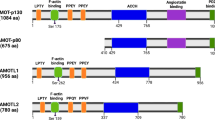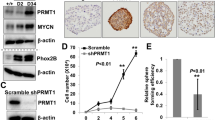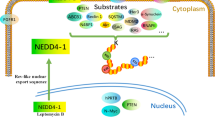Abstract
Arginylation is an emerging post-translational modification mediated by arginyltransferase (ATE1) that is essential for mammalian embryogenesis and regulation of the cytoskeleton. Here, we discovered that Ate1-knockout (KO) embryonic fibroblasts exhibit tumorigenic properties, including abnormally rapid contact-independent growth, reduced ability to form cell–cell contacts and chromosomal aberrations. Ate1-KO fibroblasts can form large colonies in Matrigel and exhibit invasive behavior, unlike wild-type fibroblasts. Furthermore, Ate1-KO cells form tumors in subcutaneous xenograft assays in immunocompromised mice. Abnormal growth in these cells can be partially rescued by reintroduction of stably expressed specific Ate1 isoforms, which also reduce the ability of these cells to form tumors. Tumor array studies and bioinformatics analysis show that Ate1 is downregulated in several types of human cancer samples at the protein level, and that its transcription level inversely correlates with metastatic progression and patient survival. We conclude that Ate1-KO results in carcinogenic transformation of cultured fibroblasts, suggesting that in addition to its previously known activities Ate1 gene is essential for tumor suppression and also likely participates in suppression of metastatic growth.
This is a preview of subscription content, access via your institution
Access options
Subscribe to this journal
Receive 50 print issues and online access
$259.00 per year
only $5.18 per issue
Buy this article
- Purchase on Springer Link
- Instant access to full article PDF
Prices may be subject to local taxes which are calculated during checkout








Similar content being viewed by others
References
Balzi E, Choder M, Chen WN, Varshavsky A, Goffeau A . Cloning and functional analysis of the arginyl-tRNA-protein transferase gene ATE1 of Saccharomyces cerevisiae. J Biol Chem 1990; 265: 7464–7471.
Kaji H, Novelli GD, Kaji A . A soluble amino acid-incorporating system from rat liver. Biochim Biophys Acta 1963; 76: 474–477.
Kwon YT, Kashina AS, Davydov IV, Hu RG, An JY, Seo JW et al. An essential role of N-terminal arginylation in cardiovascular development. Science 2002; 297: 96–99.
Karakozova M, Kozak M, Wong CC, Bailey AO, Yates JR 3rd, Mogilner A et al. Arginylation of beta-actin regulates actin cytoskeleton and cell motility. Science 2006; 313: 192–196.
Kurosaka S, Leu NA, Zhang F, Bunte R, Saha S, Wang J et al. Arginylation-dependent neural crest cell migration is essential for mouse development. PLoS Genet 2010; 6: e1000878.
Saha S, Wong CC, Xu T, Namgoong S, Zebroski H, Yates JR 3rd et al. Arginylation and methylation double up to regulate nuclear proteins and nuclear architecture in vivo. Chem Biol 2011; 18: 1369–1378.
Wang J, Han X, Wong CC, Cheng H, Aslanian A, Xu T et al. Arginyltransferase ATE1 catalyzes midchain arginylation of proteins at side chain carboxylates in vivo. Chem Biol 2014; 21: 331–337.
Wong CC, Xu T, Rai R, Bailey AO, Yates JR 3rd, Wolf YI et al. Global analysis of posttranslational protein arginylation. PLoS Biol 2007; 5: e258.
Zhang F, Saha S, Kashina A . Arginylation-dependent regulation of a proteolytic product of talin is essential for cell-cell adhesion. J Cell Biol 2012; 197: 819–836.
Saha S, Kashina A . Posttranslational arginylation as a global biological regulator. Dev Biol 2011; 358: 1–8.
Rai R, Kashina A . Identification of mammalian arginyltransferases that modify a specific subset of protein substrates. Proc Natl Acad Sci USA 2005; 102: 10123–10128.
Eisenach PA, Schikora F, Posern G . Inhibition of arginyltransferase 1 induces transcriptional activity of myocardin-related transcription factor A (MRTF-A) and promotes directional migration. J Biol Chem 2014; 289: 35376–35387.
Kwon YT, Kashina AS, Varshavsky A . Alternative splicing results in differential expression, activity, and localization of the two forms of arginyl-tRNA-protein transferase, a component of the N-end rule pathway. Mol Cell Biol 1999; 19: 182–193.
Rai R, Mushegian A, Makarova K, Kashina A . Molecular dissection of arginyltransferases guided by similarity to bacterial peptidoglycan synthases. EMBO Rep 2006; 7: 800–805.
Piatkov KI, Brower CS, Varshavsky A . The N-end rule pathway counteracts cell death by destroying proapoptotic protein fragments. Proc Natl Acad Sci USA 2012; 109: E1839–E1847.
Wang J, Han X, Saha S, Xu T, Rai R, Zhang F et al. Arginyltransferase is an ATP-independent self-regulating enzyme that forms distinct functional complexes in vivo. Chem Biol 2011; 18: 121–130.
Mihaly Z, Kormos M, Lanczky A, Dank M, Budczies J, Szasz MA et al. A meta-analysis of gene expression-based biomarkers predicting outcome after tamoxifen treatment in breast cancer. Breast Cancer Res Treat 2013; 140: 219–232.
Gyorffy B, Stelniec-Klotz I, Sigler C, Kasack K, Redmer T, Qian Y et al. Effects of RAL signal transduction in KRAS- and BRAF-mutated cells and prognostic potential of the RAL signature in colorectal cancer. Oncotarget 2015; 6: 13334–13346.
Acknowledgements
This work was supported by NIH grants GM104003 and GM117984 and the Pilot Grant from the Mari Lowe Center for Comparative Oncology to AK. BG was supported by the OTKA K108655 grant. MS was supported by NIH grant GM109091. FZ, MDB and A Kumar were partly supported by a Developmental Grant from Sylvester Comprehensive Cancer Center.
Author information
Authors and Affiliations
Corresponding author
Ethics declarations
Competing interests
The authors declare no conflict of interest.
Additional information
Supplementary Information accompanies this paper on the Oncogene website
Supplementary information
Rights and permissions
About this article
Cite this article
Rai, R., Zhang, F., Colavita, K. et al. Arginyltransferase suppresses cell tumorigenic potential and inversely correlates with metastases in human cancers. Oncogene 35, 4058–4068 (2016). https://doi.org/10.1038/onc.2015.473
Received:
Revised:
Accepted:
Published:
Issue Date:
DOI: https://doi.org/10.1038/onc.2015.473
This article is cited by
-
Arginyltransferase 1 modulates p62-driven autophagy via mTORC1/AMPk signaling
Cell Communication and Signaling (2024)
-
Heat stress induced arginylation of HuR promotes alternative polyadenylation of Hsp70.3 by regulating HuR stability and RNA binding
Cell Death & Differentiation (2021)
-
Reduced Arginyltransferase 1 is a driver and a potential prognostic indicator of prostate cancer metastasis
Oncogene (2019)
-
Arginylated Calreticulin Increases Apoptotic Response Induced by Bortezomib in Glioma Cells
Molecular Neurobiology (2019)
-
Protein arginylation regulates cellular stress response by stabilizing HSP70 and HSP40 transcripts
Cell Death Discovery (2016)



